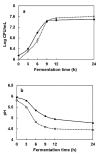Improved Antioxidant, Anti-inflammatory, and Anti-adipogenic Properties of Hydroponic Ginseng Fermented by Leuconostoc mesenteroides KCCM 12010P
- PMID: 31527401
- PMCID: PMC6767091
- DOI: 10.3390/molecules24183359
Improved Antioxidant, Anti-inflammatory, and Anti-adipogenic Properties of Hydroponic Ginseng Fermented by Leuconostoc mesenteroides KCCM 12010P
Abstract
Hydroponic ginseng (HPG) has been known to have various bio-functionalities, including an antioxidant effect. Recently, fermentation by lactic acid bacteria has been studied to enhance bio-functional activities in plants by biologically converting their chemical compounds. HPG roots and shoots were fermented with Leuconostoc mesenteroides KCCM 12010P isolated from kimchi. The total phenolic compounds, antioxidant, anti-inflammatory, and anti-adipogenic effects of these fermented samples were evaluated in comparison with non-fermented samples (control). During 24 h fermentation of HPG roots and shoots, the viable number of cells increased to 7.50 Log colony forming unit (CFU)/mL. Total phenolic and flavonoid contents of the fermented HPG roots increased by 107.19% and 645.59%, respectively, compared to non-fermented HPG roots. The antioxidant activity of fermented HPG, as assessed by 2,2'-azino-bis-3-ethylbenzothiazoline-6-sulfonic acid (ABTS), β-carotene-linoleic, and ferric reducing antioxidant power (FRAP) assay, was also significantly enhanced. In an anti-inflammatory effect of lipopolysaccharide (LPS)-stimulated RAW 264.7 cells, the nitric oxide content and the expression of inducible nitric oxide synthase (iNOS), tumor necrosis factor-α (TNF-α), interleukin-1β (IL-1β), and interleukin-6 (IL-6) decreased when treated with fermented samples. Simultaneously, lipid accumulation in 3T3-L1 adipocyte was reduced when treated with fermented HPG. Fermentation by L. mesenteroides showed improved antioxidant, anti-inflammatory and anti-adipogenic HPG effects. These results show that fermented HPG has potential for applications in the functional food industry.
Keywords: Panax ginseng; anti-adipogenic effect; anti-inflammatory effect; antioxidative effect; fermentation; hydroponic ginseng.
Conflict of interest statement
The authors declare no conflicts of interest.
Figures





Similar articles
-
Antioxidant Activity and Inhibitory Effect on Nitric Oxide Production of Hydroponic Ginseng Fermented with Lactococcus lactis KC24.Antioxidants (Basel). 2021 Oct 13;10(10):1614. doi: 10.3390/antiox10101614. Antioxidants (Basel). 2021. PMID: 34679749 Free PMC article.
-
Phenolic Compounds and Ginsenosides in Ginseng Shoots and Their Antioxidant and Anti-Inflammatory Capacities in LPS-Induced RAW264.7 Mouse Macrophages.Int J Mol Sci. 2019 Jun 17;20(12):2951. doi: 10.3390/ijms20122951. Int J Mol Sci. 2019. PMID: 31212928 Free PMC article.
-
Comparative study on anti-oxidative and anti-inflammatory properties of hydroponic ginseng and soil-cultured ginseng.Food Sci Biotechnol. 2018 Aug 30;28(1):215-224. doi: 10.1007/s10068-018-0450-x. eCollection 2019 Feb. Food Sci Biotechnol. 2018. PMID: 30815313 Free PMC article.
-
Biological and Cosmetical Importance of Fermented Raw Materials: An Overview.Molecules. 2022 Jul 28;27(15):4845. doi: 10.3390/molecules27154845. Molecules. 2022. PMID: 35956792 Free PMC article. Review.
-
Anti-Inflammatory and Immunomodulatory Properties of Fermented Plant Foods.Nutrients. 2021 Apr 30;13(5):1516. doi: 10.3390/nu13051516. Nutrients. 2021. PMID: 33946303 Free PMC article. Review.
Cited by
-
Antioxidant Activity and Inhibitory Effect on Nitric Oxide Production of Hydroponic Ginseng Fermented with Lactococcus lactis KC24.Antioxidants (Basel). 2021 Oct 13;10(10):1614. doi: 10.3390/antiox10101614. Antioxidants (Basel). 2021. PMID: 34679749 Free PMC article.
-
Antioxidant capacity, flavor and physicochemical properties of FH06 functional beverage fermented by lactic acid bacteria: a promising method to improve antioxidant activity and flavor of plant functional beverage.Appl Biol Chem. 2023;66(1):7. doi: 10.1186/s13765-022-00762-2. Epub 2023 Jan 28. Appl Biol Chem. 2023. PMID: 36742290 Free PMC article.
-
Antiviral activity of fermented foods and their probiotics bacteria towards respiratory and alimentary tracts viruses.Food Control. 2021 Sep;127:108140. doi: 10.1016/j.foodcont.2021.108140. Epub 2021 Apr 11. Food Control. 2021. PMID: 33867696 Free PMC article. Review.
-
Fecal microbiota related to postoperative endoscopic recurrence in patients with Crohn's disease.Gastroenterol Rep (Oxf). 2024 Mar 23;12:goae017. doi: 10.1093/gastro/goae017. eCollection 2024. Gastroenterol Rep (Oxf). 2024. PMID: 38524186 Free PMC article.
-
Antioxidant Effect and Sensory Evaluation of Yogurt Supplemented with Hydroponic Ginseng Root Extract.Foods. 2021 Mar 17;10(3):639. doi: 10.3390/foods10030639. Foods. 2021. PMID: 33802997 Free PMC article.
References
-
- Garruti D.S., Franco M.R.B., da Silva M.A.A.P., Janzantti N.S., Alves G.L. Assessment of aroma impact compounds in a cashew apple-based alcoholic beverage by GC–MS and GC-olfactometry. LWT- Food Sci. Technol. 2006;39:373–378. doi: 10.1016/j.lwt.2005.02.006. - DOI
-
- Eom S.J., Hwang J.E., Kim H.S., Kim K.-T., Paik H.-D. Anti-inflammatory and cytotoxic effects of ginseng extract bioconverted by Leuconostoc mesenteroides KCCM 12010P isolated from kimchi. Int. J. Food Sci. Technol. 2018;53:1331–1337. doi: 10.1111/ijfs.13713. - DOI
MeSH terms
Substances
LinkOut - more resources
Full Text Sources
Medical
Miscellaneous

